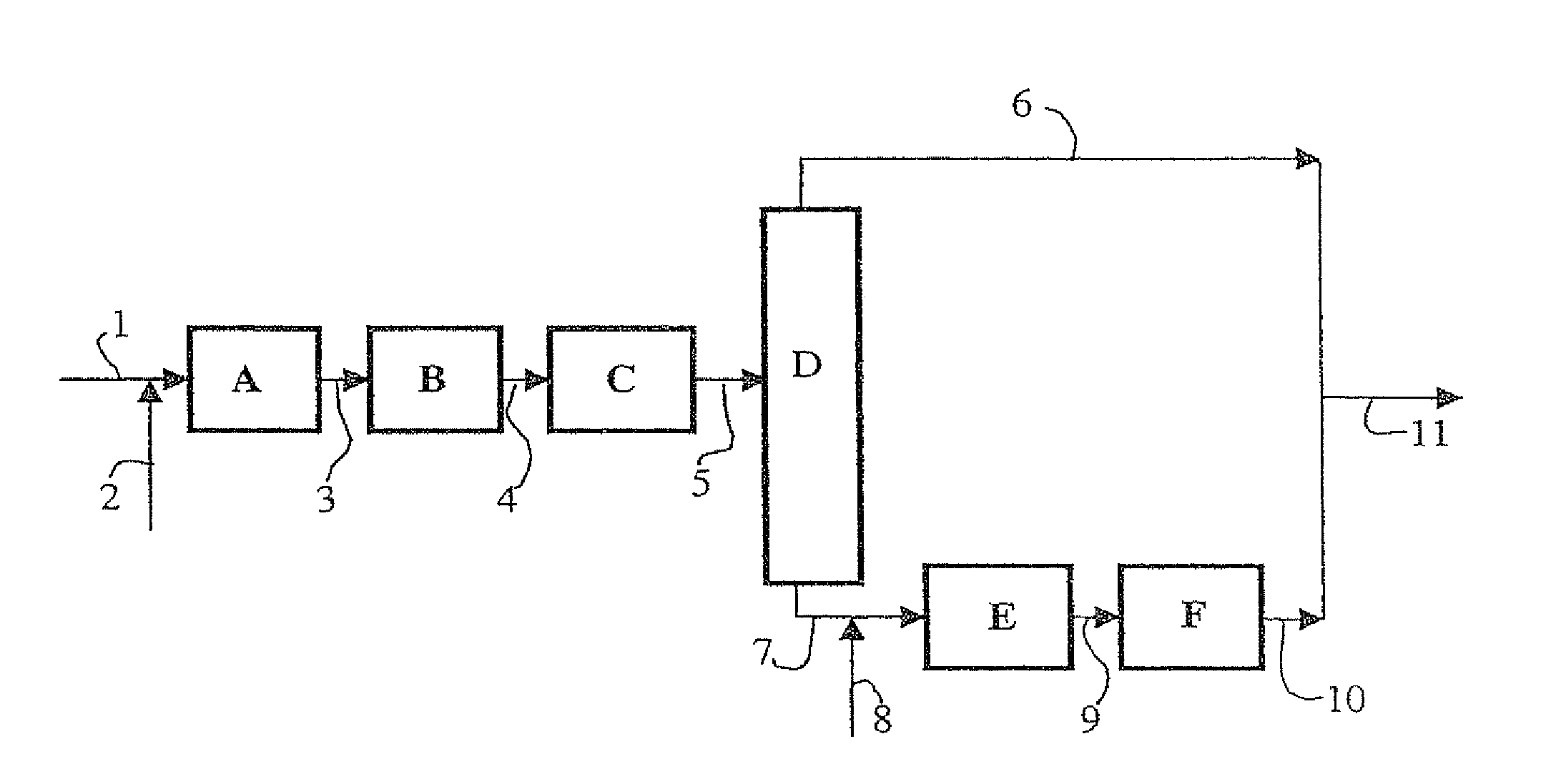Process for the production of a desulfurized gasoline from a gasoline fraction that contains conversion gasoline
a technology of conversion gasoline and gasoline fraction, which is applied in the direction of hydrocarbon oil cracking, hydrocarbon oil treatment products, organic chemistry, etc., can solve the problems of high investment, significant hydrogen consumption and high investment, and significant drop in the octane number of the fraction
- Summary
- Abstract
- Description
- Claims
- Application Information
AI Technical Summary
Benefits of technology
Problems solved by technology
Method used
Image
Examples
example 1 (
For Comparison)
[0150]A cracking gasoline is subjected to a hydrogenation treatment of the diolefins under conditions where the saturated sulfur-containing light compounds that are present in the feedstock are partly converted into heavier compounds.
[0151]This treatment is carried out in a continuously-operating reactor. The catalyst has a nickel and molybdenum base (catalyst marketed by the Procatalyse Company under reference HR945). The reaction is performed at 180° C. under a total pressure of 2.6 MPa, with a volumetric flow rate of 6 h−1. The H2 / feedstock ratio, expressed in liter of hydrogen per liter of feedstock is 10.
[0152]The characteristics of the catalytic cracking gasoline and the effluent after hydrogenation of diolefins and conversion of light compounds are indicated in Table 1.
[0153]
TABLE 1Gasoline afterHydrogenationStarting Gasoline(Stages a and b)Density 15 / 40.72150.7237Bromine Number (gBr / 100 g)7874Olefins (GC) % by weight4340.5MAV (mg / g)100.2Research Octane9392.5Nu...
example 2 (
For Comparison)
[0158]The catalytic cracking gasoline that is obtained in Example, after hydrogenation treatment is separated into two fractions, a light fraction that represents 20% by weight of distilled gasoline whose fraction point corresponds to a temperature of 55° C. and a heavy fraction. The separation is carried out on the same column as in Example 1. The characteristics of the two fractions that are obtained are provided in Table 3.
[0159]
TABLE 3Light FractionHeavy FractionPI-5555-175Density 15 / 40.650.77Bromine Number (gBr / 100 g)13065Olefins (GC)6036MAV (mg / g)Research Octane Number9590.5Motor Octane Number81.580Mercaptans (ppm)4S Total (ppm)2437Fraction Points (DS) 0.5%452 5%205410%226750%3610290%4113895%5415199.5%72176
[0160]The light gasoline that is produced by distillation exhibits contents of mercaptans, diolefins and sulfur such that it can be used directly.
[0161]The heavy gasoline requires an additional desulfurization.
[0162]The heavy gasoline is therefore subjected to...
example 3 (
According to the Invention)
[0170]The catalytic cracking gasoline that is obtained in Example 1 after hydrogenation treatment [stages a) and b) according to the invention] is sent to a reactor for increasing the weight of sulfur-containing compounds by alkylation by the olefins (stage c) according to the invention). This stage is implemented in a tubular reactor that contains catalyst with a phosphoric acid base that is supported on silica that contains 20% by weight of phosphoric acid (catalyst C) under the following operating conditions: VVH=1 h-1, pressure=2.0 MPa, temperature=180° C. Before injection in the reactor, the feedstock is supplemented with isopropanol at a level of 500 ppm, intended to hydrate the catalyst continuously in the reactor.
[0171]The effluent that is thus produced is separated into two fractions with a distillation column as described in Example 1. The distillation fraction point is set at 100° C.; the light fraction represents 50% by weight of the starting g...
PUM
| Property | Measurement | Unit |
|---|---|---|
| boiling points | aaaaa | aaaaa |
| boiling points | aaaaa | aaaaa |
| boiling point | aaaaa | aaaaa |
Abstract
Description
Claims
Application Information
 Login to View More
Login to View More - R&D
- Intellectual Property
- Life Sciences
- Materials
- Tech Scout
- Unparalleled Data Quality
- Higher Quality Content
- 60% Fewer Hallucinations
Browse by: Latest US Patents, China's latest patents, Technical Efficacy Thesaurus, Application Domain, Technology Topic, Popular Technical Reports.
© 2025 PatSnap. All rights reserved.Legal|Privacy policy|Modern Slavery Act Transparency Statement|Sitemap|About US| Contact US: help@patsnap.com

